Run Macro in Excel enables users to execute complex tasks with a single click, significantly enhancing productivity and accuracy in data handling. This powerful feature allows for the automation of repetitive tasks, streamlined data analysis, and the creation of custom functions tailored to specific needs. By integrating Run Macro into your Excel workflow, you can save time, reduce errors, and focus more on strategic decision-making. Harness the full potential of Excel macros to transform your data management practices and unlock new levels of efficiency and effectiveness in your work.
This Tutorial Covers:
- What is macro in Excel?
- How to enable macro in Excel?
- How to record a macro in Excel?
- How to run macro from Excel ribbon?
- How to run a macro with custom keyboard shortcut?
- How to run macro from Visual Basic Editor?
- How to create macro button in Excel?
- How to make macro button from a graphic object?
- How to add macro button to Quick Access Toolbar?
- How to Put macro button on Excel ribbon?
1. What is macro in Excel?
An Excel macro is a set of actions or actions with which you can record and run indefinitely to automate repetitive work. The macro saves your keystrokes and clicks and allows users to rerun them with a single click. Running an Excel macro is simple for experienced users, but it may not be obvious to beginners.
2. How to enable macro in Excel?
To begin, enable the Developer tab.
To operate a macro, initially enable the Developer tab so that it is viewable on the Excel ribbon. Because it is not visible by default, you must manually add it.
Step 1: Go to File.
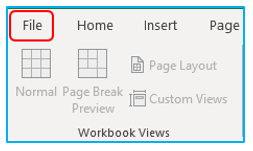
Step 2: Click Options.
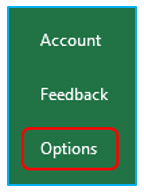
Step 3: Select Customize Ribbon.
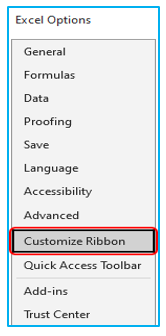
Step 4: Select the Developer checkbox under Main Tabs.
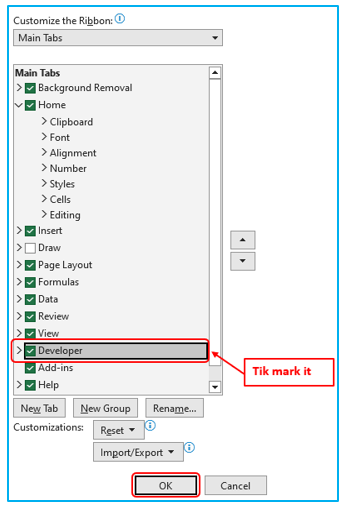
Step 5: Click OK.
Result outlined below:

Added in the excel ribbon.
3. How to record a macro in Excel?
Step 1: Click Record Macro on the Developer tab’s Code group.

Step 2: Name the macro in the Macro name box, being as descriptive as possible.
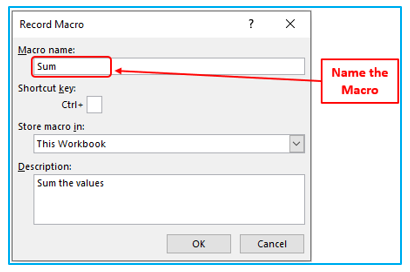
Step 3: Select where you want to save the macro by clicking the drop-down arrow to the right of the Store macro in box.
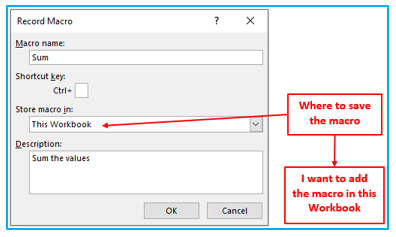
Step 4: To create a shortcut for the macro, type an upper-case or lower-case letter in the Shortcut key box. It is possible that Excel will prevent you from using an existing shortcut key. In this case, it’s best to create a one-of-a-kind key.
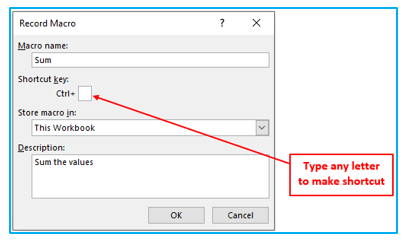
Step 5: In the Description box, write a description of what the macro does.
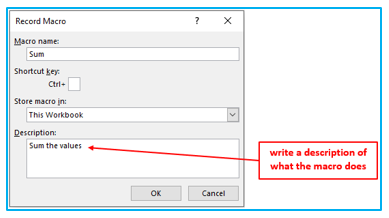
Step 6: To begin recording, click OK.
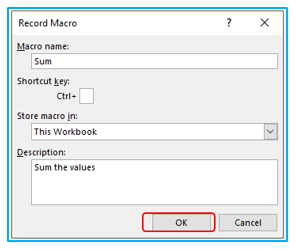
Step 7: Perform steps that you want to save to perform future tasks.
Step 8: Click Stop Recording on the Developer tab.

4. How to run macro from Excel ribbon
Running a macro from the Developer tab is one of the quickest ways to execute VBA in Excel. To run a macro in excel from the Developer tab, follow these steps:
Step 1: Click Macros in the Code group on the Developer tab. Alternately, use the Alt + F8 shortcut.

Step 2: Select the macro of interest from the Macro dialog box, and then click Run.
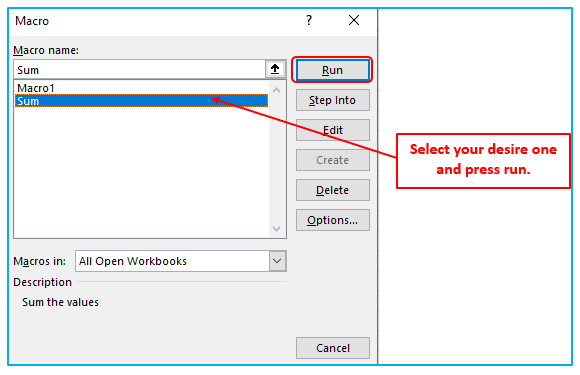
5. How to run a macro with custom keyboard shortcut?
When you employ a specific macro on a regular basis, you can assign it a shortcut key. A shortcut can be added to both a new macro and an existing one. Follow these steps to accomplish this:
Step 1: Click Macros in the Code group on the Developer tab. Alternately, use the Alt + F8 shortcut.

Step 2: Select the macro to which you want to assign the shortcut key from the Macro name box.
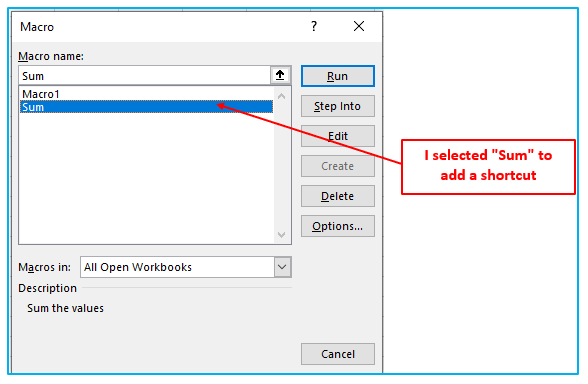
Step 3: To open the Macro Options dialog box, click the Options button.
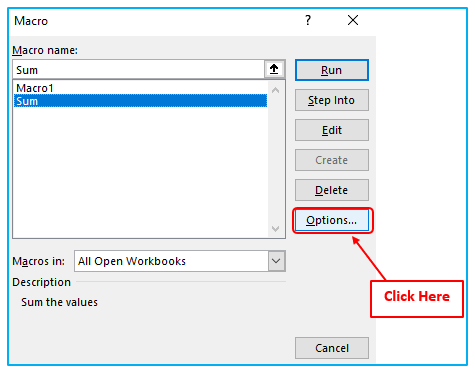
Step 4: The Macro Options dialog box appears. In the Shortcut key box, type the letter you want for your custom keyboard shortcut.
- Ctrl + letter is the shortcut for lowercase letters.
- Ctrl + Shift + letter is the shortcut for uppercase letters.
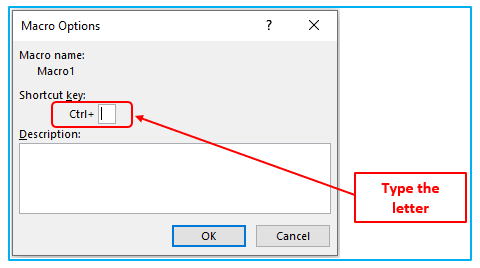
Or,
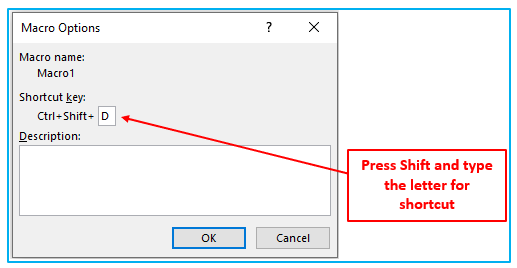
To avoid overriding the default Excel shortcuts, always use uppercase key combinations for macros (Ctrl + Shift + letter). If you assign ‘Ctrl + c’ to a macro, for example, you will lose access to copy anything.
Step 5: In the Macro Options menu, click the OK button.
Step 6: In the Macros menu, click the Cancel button.
6. How to run macro from Visual Basic Editor?
Follow these steps to run macro in excel from the VBE:
Step 1: Go to the Developer tab. To open the VBE, select Visual Basic. By pressing Alt + F11, you can also access the VBE (Windows)

Step 2: To open the module containing your macro, double-click it in the Project Explorer window on the left.
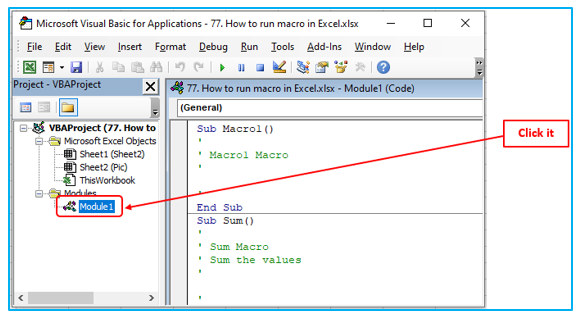
Step 3: Put the cursor anywhere within the macro that you want to run and then do one of the following:
- Tap on the Run then click on Run Macro
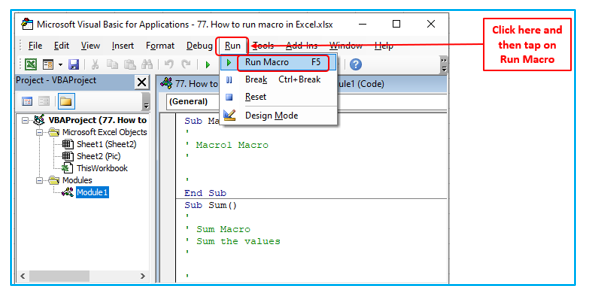
- Click the Run Macro button on the toolbar (green triangle).
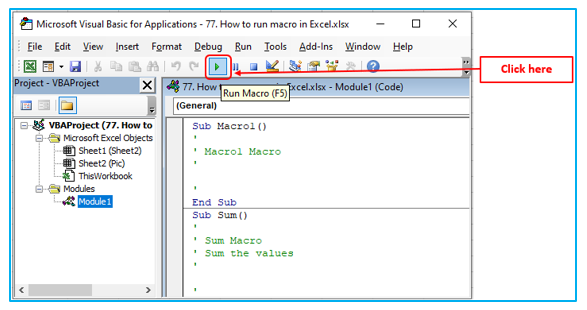
You can also use either of these shortcuts:
- To run the entire code, press F5.
- To run each code line separately, press F8.
7. How to create macro button in Excel?
To assign a macro to a button, follow these steps:
Step 1: Navigate to the Developer tab, then in the Controls group, click on Insert and after that click on the Button.
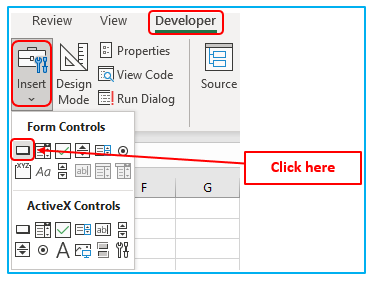
Step 2: Simply click anywhere on the worksheet. This brings up the Assign Macro dialog box.
Step 3: Choose the macro you want to assign to the button and press OK.
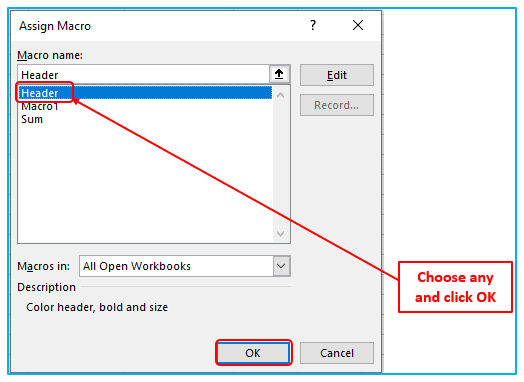
Step 4: In the worksheet, a button is added. Right-click the button and select Edit Text from the context menu to change the text.
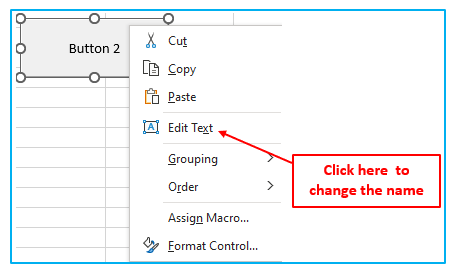
Step 5: Remove the default text, such as Button 1, and replace it with your own.
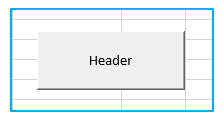
You have now managed to add a button to your Excel worksheet which, once clicked, will execute the assigned macro.

8. How to make macro button from a graphic object?
Unfortunately, there is no possible to customize the appearance of button controls, so the button we just created does not look very nice. Shapes, icons, images, WordArt, and other objects can be used to create a truly beautiful Excel macro button.
Here’s how to launch a macro by tapping a shape:
Step 1: Click Shapes on the Insert tab, in the Illustrations group, and then select the desired shape type, such as a Oval:
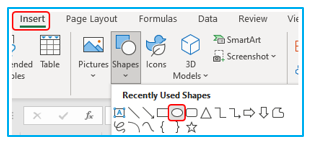
Step 2: Click where you want to insert the shape object in your worksheet.
Step 3: Make your shape-button however you want. Simply double-click the shape and begin typing to add text.

Step 4: To assign a macro to a shape, right-click it and select Assign Macro…, then select the desired macro and click OK.
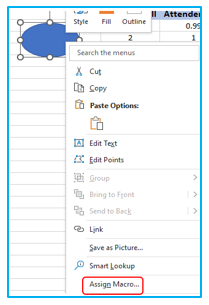
You have now managed to add a button to your Excel worksheet which, once clicked, will execute the assigned macro.
Results outlined below:

9. How to Add macro button to Quick Access Toolbar?
Here’s how to add macro button to Quick Access Toolbar:
Step 1: Right-click on the Quick Access toolbar and select More Commands… from the drop-down menu.
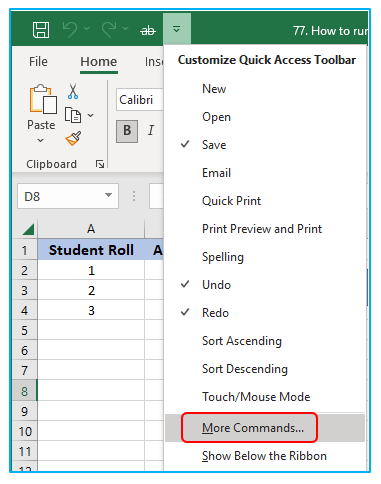
Step 2: Select Macros from the dropdown list of commands.
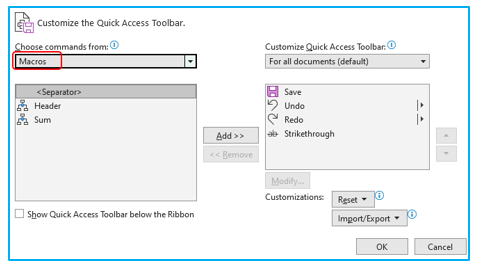
Step 3: Choose the macro to add to your Quick Access Toolbar.
Step 4: Click the Add button.
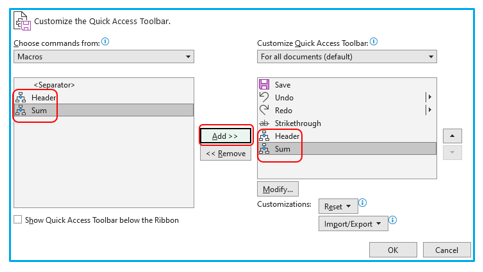
Step 5: Click the OK button.
Result outlined below:
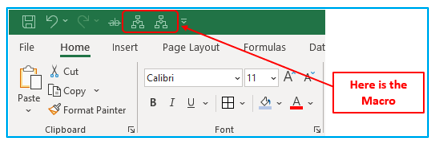
10. How to Put macro button on Excel ribbon?
Here’s how to put macro button on Excel ribbon:
Step 1: Click anywhere on the Excel ribbon to bring up the context menu.
Step 2: From the menu, choose Customize the Ribbon.
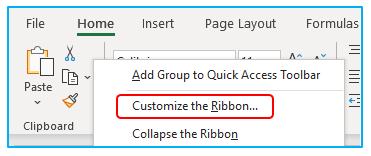
Step 3: To make a new ribbon tab, click the New Tab button.
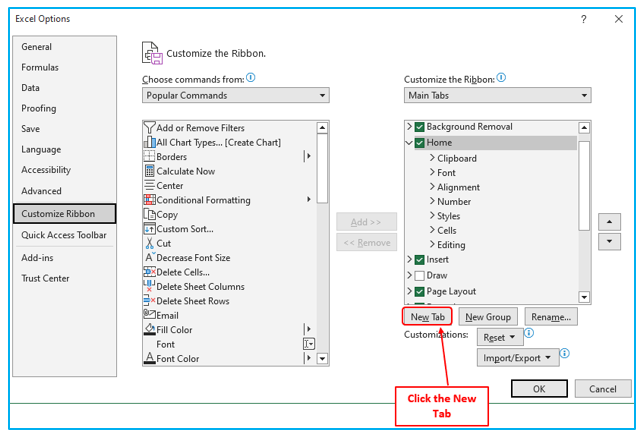
Step 4: Give your tab a name by pressing the Rename button.
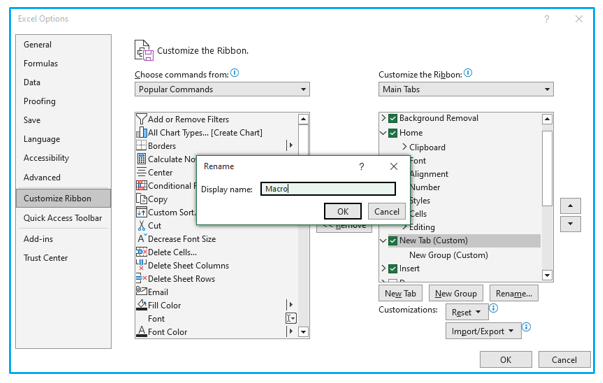
Step 5: Choose Macros from the Choose commands from a dropdown menu.
Step 6: Choose the macro you want to include in the ribbon.
Step 7: Click the Add button.
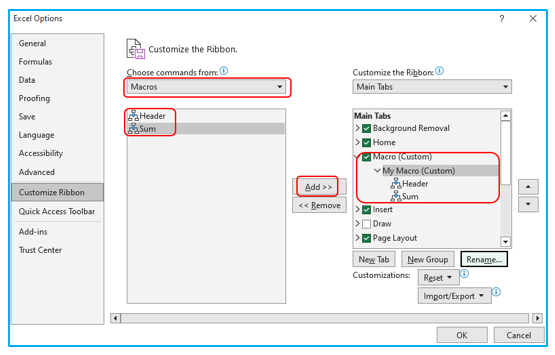
Step 8: Click the OK button.
Result outlined below:
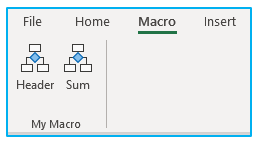
Application of Run Macro in Excel
- Automate Repetitive Tasks: Use Run Macro in Excel to execute repetitive tasks like formatting reports, inserting functions, or data entry, saving time and ensuring consistency.
- Data Analysis Automation: Automate complex data analysis sequences, such as sorting, filtering, and applying statistical functions to large datasets for quick, consistent results.
- Batch Processing: Perform batch operations like updating multiple records, converting data formats, or mass-importing/exporting data to streamline workflow efficiency.
- Custom Reporting: Generate custom reports by running macros that compile data from various sources, apply specific formats, and create charts or tables as per business requirements.
- Interactive Dashboard Functions: Enhance Excel dashboards by using macros to add interactive features such as buttons, dropdowns, and sliders for dynamic data exploration and visualization.
- Scheduled Data Updates: Automate the process of updating Excel sheets at scheduled intervals by running macros to refresh data connections, ensuring up-to-date information is always available.
You may be interested:
